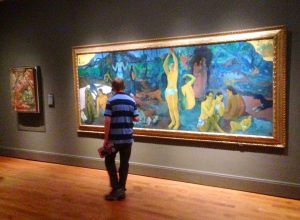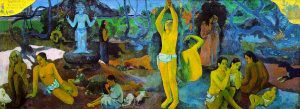Theopraxesis: Gauguin
 Capability. As these posts accumulate across an expanding set of categories, it is important to recall the focus of KE. Konsult learns the writing of the disaster in three dimensions: heuretics (invention), wide image (mystory), theopraxesis (capability). So far we have assumed some disaster addresses us, and devoted our attention to the heuretics of mystory, learning how to design an image of wide scope, source of our original hypothesis responding to disaster. Konsult takes up for electracy an ancient, even primordial drama: the striving to persist in one’s own being (to live), that Spinoza called Conatus, against the Overwhelming force of resistance, entropy, death. Heidegger characterized the drama as Riss, exploiting as was his craft German vocabulary, finding a term that means both Rift (split, break) and design (drawing). The drama of living derives from an irreducible opposition between Earth and World (nature and culture). Konsult is rift design (an assertion that must be developed elsewhere), taking up this enigmatic primordial experience of resistance encountered through living. Norbert Weiner, one of the inventors of cybernetics, defined life simply as anything that was negentropic, whether man or machine. We need to include in the drift of our posts a review of human capabilities, virtues, powers, the potentiality of egents which through education is realized in the service of well-being, thriving, living against disaster.
Capability. As these posts accumulate across an expanding set of categories, it is important to recall the focus of KE. Konsult learns the writing of the disaster in three dimensions: heuretics (invention), wide image (mystory), theopraxesis (capability). So far we have assumed some disaster addresses us, and devoted our attention to the heuretics of mystory, learning how to design an image of wide scope, source of our original hypothesis responding to disaster. Konsult takes up for electracy an ancient, even primordial drama: the striving to persist in one’s own being (to live), that Spinoza called Conatus, against the Overwhelming force of resistance, entropy, death. Heidegger characterized the drama as Riss, exploiting as was his craft German vocabulary, finding a term that means both Rift (split, break) and design (drawing). The drama of living derives from an irreducible opposition between Earth and World (nature and culture). Konsult is rift design (an assertion that must be developed elsewhere), taking up this enigmatic primordial experience of resistance encountered through living. Norbert Weiner, one of the inventors of cybernetics, defined life simply as anything that was negentropic, whether man or machine. We need to include in the drift of our posts a review of human capabilities, virtues, powers, the potentiality of egents which through education is realized in the service of well-being, thriving, living against disaster.

–Gauguin in Tahiti. An important part of KE is advisory to colleagues experimenting with transitions from literacy to electracy, adapting alphabetic curriculum and pedagogy to digital metaphysics. Posts up to now have referenced various canonical figures practicing the poetics of popcycle, mystory, wide image. The basic proposal for transition into electracy is just to reframe the curriculum within heuretics, to engage with it (following the advice of Roland Barthes) not in terms of what it means, but how it was made. This is the fundamental lesson of the avant-garde arts, relative to the new purpose of electracy which is not to communicate a meaning (literacy does that), but to access a visceral memory that otherwise remains inchoate. The practical point is that the entire curriculum manifests a continuous engagement with the three fundamental capabilities, intellectual virtues, human faculties, first defined by the Classical Greeks (Aristotle). These are the negentropic faculties or powers that are potential in every person, beginning in a state of impotence, with the mission of education being actualization of world.
–The Three Questions. Gauguin, for example. Literate schooling studies the likes of Gauguin, Momaday, Sebald, Heidegger. The heuretic frame shifts the role of these exemplars to relay: egents are positioned not as students observing from the outside some body of information, but as receivers of a tradition (tradition is Avatar, konsult is Gita (Song) by means of which egent receives the totality of what tradition knows). Let Gauguin’s masterpiece serve as emblem for a catechism fundamental to the Western tradition (Hal Foster in Prosthetic Gods proposed that this work represented the catechism of Modernism). The title consists of three questions: Where do we come from? What are we? Where are we going? These questions anchor our fundamental theme: orientation, and how it is modalized in electracy. The work must be placed in its situation, since the implicit question always is: what is that for me? Gauguin’s state of mind in Tahiti in 1897 was despair, disillusionment exacerbated by debt and illness (the primitive paradise he had imagined disappeared a hundred years before he arrived). Gauguin decided on suicide, but wanted first to paint a testament. The scene of this wall-sized tableau is a narrative, developing from right to left, the movement representing the vector of life and death (Derrida’s trace).
The upper corner chrome yellow (like damaged fresco). To the right below sleeping baby three seated women, two figures dressed in purple confide their thoughts. Enormous crouching figure (intentionally violated perspective) raises its arm and looks in astonishment at these two people who dare to think of their destiny. A figure in the center is picking fruit. Two cats near a child. A white goat. An idol, both arms rhythmically raised seem to indicate the Beyond. A crouching girl seems to listen to the idol and lastly an old woman approaching death appears reconciled to her thoughts. She completes the story. At her feet a strange white bird holing a lizard in its claws, represents a futility of words. The setting is the bank of a stream in the woods. In the background the ocean, and beyond, the mountains of a neighbboring island. In spite of changes of tone, the landscape is blue and veronese green from one end to the other. The naked figures stand out against it in bold orange. If anyone said to the students competing for the Rome Prize at the Ecole des Beaux Arts, the picture you must paint is to represent Where do we come from? What are we? Where are we going? what would they do? (Paul Gauguin, in a letter).
Yes, that question is addressed to us, egents of the EmerAgency.
